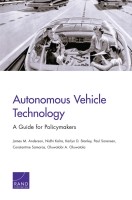| 来源类型 | Research Reports
|
| 规范类型 | 报告
|
| DOI | https://doi.org/10.7249/RR443-2
|
| ISBN | 9780833083982
|
| 来源ID | RR-443-2-RC
|
| Autonomous Vehicle Technology: A Guide for Policymakers |
| James M. Anderson; Nidhi Kalra; Karlyn D. Stanley; Paul Sorensen; Constantine Samaras; Tobi A. Oluwatola
|
| 发表日期 | 2016
|
| 出版年 | 2016
|
| 页码 | 214
|
| 语种 | 英语
|
| 结论 |
Automated Vehicle Technology Offers Several Benefits- Without driver error, fewer vehicle crashes will result.
- The mobility of the young, the elderly, and the disabled will be increased.
- Traffic flow could be more efficient and congestion decreased.
- Vehicle occupants could spend travel time engaged in other activities, so the costs of travel time and congestion are reduced.
- Fuel efficiency can be increased and alternative energy sources facilitated.
- Because such vehicles won't need proximate urban parking, space used for parking could be repurposed.
There Are Possible Drawbacks- Because the technology would decrease the cost of driving, congestion might increase, rather than decrease.
- Occupations and economies based on public transit, crash repair, and automobile insurance might suffer as the technology makes certain aspects of these occupations obsolete.
Policy Implications Include Liability and Regulation Issues- Manufacturer liability is likely to increase while personal liability is likely to decrease. If a vehicle and a human share driving responsibility, the insurance issues could become more complicated. A variety of solutions exist if this poses a problem.
- Inconsistent state regulation poses a risk — if 50 states have 50 different regulations, it would be difficult for manufacturers to match them all; likewise, vehicle owners might not be able to travel outside their state of residence.
- Because many of the benefits of autonomous vehicle technology accrue to those other than the purchaser, subsidies or taxes may be necessary in order to maximize social welfare by equalizing the public and private costs and benefits.
|
| 摘要 |
- Further research should be conducted to better quantify the likely costs and benefits of the technology and, just as importantly, to whom they will accrue.
- As the technology evolves, policymakers should consider subsidies or taxes to equalize the public and private costs and benefits of this technology.
- In general, autonomous vehicle technology ought to be permitted if and when it is superior to average human drivers.
- Judges should consider incorporating the long-run costs and benefits of a technology in ruling on product liability suits.
- At this point, aggressive policymaker intervention with respect to regulations or liability is premature and would probably do more harm than good, but that may change over time.
|
| 主题 | Autonomous Vehicles
; Communication Systems
; Emerging Technologies
; No-Fault Automobile Insurance
; Passenger Traffic
; Surface Traffic Models
; Traffic Accidents
; Traffic Congestion
; Transportation Planning
; Transportation Safety
; Urban Planning
|
| URL | https://www.rand.org/pubs/research_reports/RR443-2.html
|
| 来源智库 | RAND Corporation (United States)
|
| 引用统计 |
|
| 资源类型 | 智库出版物
|
| 条目标识符 | http://119.78.100.153/handle/2XGU8XDN/108413
|
推荐引用方式
GB/T 7714 |
James M. Anderson,Nidhi Kalra,Karlyn D. Stanley,et al. Autonomous Vehicle Technology: A Guide for Policymakers. 2016.
|
|
文件名:
|
x1535045608876.jpg
|
|
格式:
|
JPEG
|

|
文件名:
|
RAND_RR443-2.pdf
|
|
格式:
|
Adobe PDF
|
除非特别说明,本系统中所有内容都受版权保护,并保留所有权利。